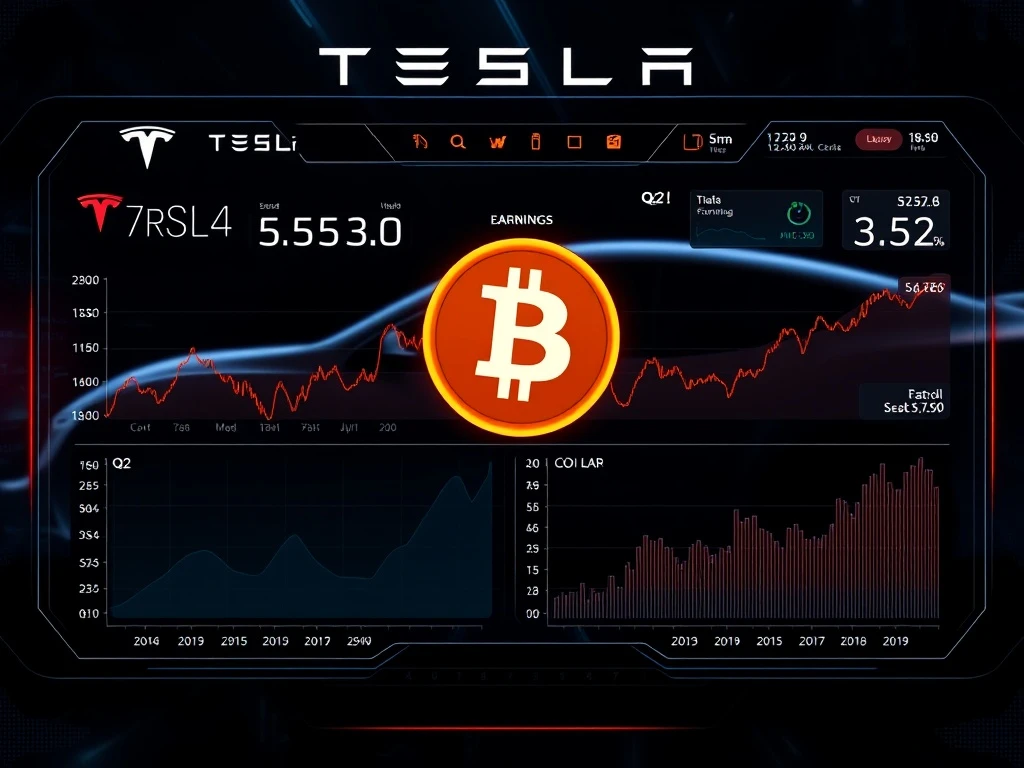Bitcoin Fuels Tesla’s Astounding Q2 Earnings Triumph

In a remarkable display of financial foresight, Tesla’s Q2 2025 earnings report has sent ripples through both the automotive and cryptocurrency worlds. The electric vehicle giant announced a near-tripling of its quarterly earnings compared to Q1, a significant portion of which was directly attributed to its strategic Bitcoin holdings. For anyone invested in the volatile yet rewarding realm of digital assets, this news underscores the growing impact of Bitcoin on corporate balance sheets.
How Did Bitcoin Boost Tesla’s Q2 Earnings So Significantly?
Tesla’s second-quarter performance in 2025 was nothing short of spectacular, largely thanks to its forward-thinking investment in digital assets. The company reported a staggering $284 million in earnings directly from its Bitcoin holdings. To put this into perspective, this single contribution from Bitcoin surpassed Tesla’s entire net income for the first quarter of the year. With a total net income reaching $1.2 billion for Q2, the contrast with Q1’s $409 million is stark, highlighting a nearly threefold increase.
The primary catalyst for these impressive gains was the surge in Bitcoin prices throughout the period. Tesla’s crypto reserves, estimated at approximately 11,500 bitcoins, experienced substantial appreciation. This appreciation not only bolstered the company’s balance sheet but also provided a crucial financial cushion amidst ongoing challenges in its core automotive business. This demonstrates how a well-timed crypto investment can act as a powerful financial lever for major corporations.
Tesla’s Strategic Crypto Investment: A Diversification Power Play
Tesla’s decision to integrate Bitcoin into its treasury strategy has evolved beyond a mere speculative venture; it has become a critical component of its financial diversification. Analysts have pointed out that Bitcoin‘s role provides essential liquidity and operational flexibility, allowing Tesla to navigate a complex economic landscape. Despite the inherent volatility of crypto markets, the company’s leadership has consistently emphasized their strategic value. Tesla affirmed its commitment to “continue to shape [its] investment strategy” while closely monitoring market developments [2].
This approach highlights a broader trend where companies are exploring non-traditional assets to fortify their financial positions. For Tesla, Bitcoin‘s contribution to its cash reserves has directly offset declines in automotive profitability, which saw a 12% year-over-year revenue drop in Q2. CFO Vaibhav Taneja reiterated that Tesla remains “absorbing these costs while prioritizing long-term resilience,” with Bitcoin earnings serving as a vital buffer [3]. This strategic depth is a key takeaway for any business considering diversification.
Navigating Challenges: Automotive Headwinds and Energy Sector Growth
While the Bitcoin gains stole headlines, Tesla‘s Q2 also revealed a mixed bag of performance. The automotive segment faced significant headwinds, including waning demand for electric vehicles and increasing regulatory pressures. Furthermore, the core business incurred an estimated $300 million in tariff costs and reduced EV incentives, largely due to Trump administration policies, which further strained profit margins [3].
However, Tesla‘s resilience was evident in the robust growth of its energy division. This segment reported a gross profit of $846 million in Q2, marking an impressive 48% year-over-year increase [1]. The energy division now generates nearly a third of Tesla‘s total gross profit, positioning it as a pivotal revenue stream alongside the Bitcoin-related gains. This dual-pronged approach, leveraging both innovative energy solutions and digital asset investment, showcases Tesla‘s adaptability in the face of market challenges.
Elon Musk’s Stance and the Volatile Bitcoin Market
Even with substantial Bitcoin gains, CEO Elon Musk has maintained a characteristically cautious stance on cryptocurrencies. His public remarks often reflect broader concerns about market stability and regulatory risks. For instance, his comments, including a jab at Trump’s tax legislation, have at times coincided with temporary dips in Bitcoin prices. A notable example occurred in May, when revelations linking Trump to the Epstein file triggered a price decline, aligning with White House confirmations that Trump had been briefed on the matter [1].
Such instances underscore the intricate interplay between geopolitical events, public sentiment, and crypto market volatility. Despite these fluctuations and Musk’s cautious tone, Tesla‘s continued holding of significant Bitcoin reserves signals a long-term commitment to digital assets. It highlights a strategic acceptance of volatility as part of a larger financial investment strategy.
What’s Next for Tesla’s Financial Strategy and Future Growth?
Looking ahead, experts suggest that Tesla‘s crypto strategy could continue to evolve, particularly as the company explores new investment approaches in tech-driven sectors. The synergy between its rapidly growing energy segment and the substantial Bitcoin-related earnings is expected to remain pivotal to its financial health. Furthermore, Tesla‘s announcement of an upcoming affordable EV model, while still in early stages, signals a broader effort to diversify revenue streams and appeal to a wider market [3].
The dynamic interplay between Tesla‘s core operations and its digital asset investment strategy reflects a broader industry trend. Automakers, like many other large corporations, are increasingly leveraging non-traditional assets to counteract margin pressures and enhance financial resilience. As regulatory landscapes shift and Bitcoin prices fluctuate, Tesla‘s ability to skillfully balance these diverse elements will be crucial for sustaining its impressive momentum and securing its long-term success.
In conclusion, Tesla‘s Q2 2025 earnings report paints a clear picture: Bitcoin is no longer just a speculative asset but a powerful tool for corporate financial diversification. The company’s ability to leverage its crypto holdings to offset challenges in its core business, while simultaneously growing its energy sector, demonstrates remarkable strategic foresight. As the digital asset landscape continues to mature, Tesla‘s journey will undoubtedly serve as a compelling case study for other corporations navigating the future of finance.
Frequently Asked Questions (FAQs)
Q1: How much did Bitcoin contribute to Tesla’s Q2 2025 earnings?
Tesla reported $284 million in earnings from its Bitcoin investments in Q2 2025, which significantly boosted its overall net income for the quarter.
Q2: Why does Tesla hold Bitcoin?
Tesla holds Bitcoin as part of its financial diversification strategy. It provides liquidity and operational flexibility, acting as a buffer against challenges in its core automotive business and enhancing its balance sheet.
Q3: Did Tesla’s core automotive business perform well in Q2 2025?
While Tesla’s overall earnings were strong due to Bitcoin and energy, its automotive segment faced challenges including waning demand, regulatory pressures, and tariff costs, resulting in a 12% year-over-year revenue drop.
Q4: What is Elon Musk’s stance on cryptocurrencies?
Elon Musk maintains a cautious stance on cryptocurrencies, acknowledging their volatile nature and regulatory risks, despite Tesla’s strategic investment in Bitcoin.
Q5: What other areas contributed to Tesla’s strong Q2 performance?
Beyond Bitcoin, Tesla’s energy division showed robust growth, with gross profit reaching $846 million in Q2, a 48% year-over-year increase, contributing significantly to the company’s overall financial health.








